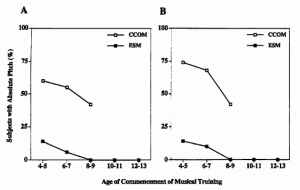絶対音感を身につけるタイミング
2013年 1月 29日に、音楽に関する sensitive periodについての論文を紹介しました。
絶対音感にも、sensitive periodがあり、大人になってから身につけようと思っても、まず無理です。「では、何歳までなら大丈夫なのか?」という問いに答えた論文を見つけましたので、紹介します。
Absolute pitch among American and Chinese conservatory students: Prevalence differences, and evidence for a speech-related critical period a
Absolute pitch is extremely rare in the U.S. and Europe; this rarity has so far been unexplained. This paper reports a substantial difference in the prevalence of absolute pitch in two normal populations, in a large-scale study employing an on-site test, without self-selection from within the target populations. Music conservatory students in the U.S. and China were tested. The Chinese subjects spoke the tone language Mandarin, in which pitch is involved in conveying the meaning of words. The American subjects were nontone language speakers. The earlier the age of onset of musical training, the greater the prevalence of absolute pitch; however, its prevalence was far greater among the Chinese than the U.S. students for each level of age of onset of musical training. The findings suggest that the potential for acquiring absolute pitch may be universal, and may be realized by enabling infants to associate pitches with verbal labels during the critical period for acquisition of features of their native language.
© 2006 Acoustical Society of America
[背景]
絶対音感は、参照にする音がなくても音名がわかったり、その高さの音を出したりする能力ですが、アメリカやヨーロッパでは非常に稀とされ、おそらく 10000人に 1人以下であると言われています。稀ということもあって、絶対音感はしばしば、非常に優れた能力であるとみなされます。しかし、実際には絶対音感がなくても優れた音楽能力を持つ人はたくさんいます。ドイチュらは、2006年の論文に「ヴェトナム語と北京語を母国語として話す人たちは、単語のリストを読む時に非常に正確な絶対音感を示す」ことを報告しました。
声調言語はピッチの高さとそのコントロールに規定されます。声調言語である北京語では、例えば「マー」と発音したとき、第一声 (高い音で平板に) だと母、第二声 (中ぐらいの高さで始めてさらに高く) だと麻、第三声 (中ぐらいの高さからいったん低く下げ、最後は尻上がりに) だと馬、第四声 (高い音から低い音に下げる) だと非難・・・といった感じです。このように微妙なピッチの感覚を子供の頃から身につけていると、絶対音感取得に役立つのではないかというのがドイチュらの推測です。さらにドイチュらは英語のような非声調言語より、声調言語の方が絶対音感の保持率が高くなるのではないかと推測しました。子供の頃に微妙なピッチの感覚が身につかない非声調言語では、それを応用して絶対音感を身につけることができないので、特に音楽を開始する年齢が強調されるのです。
今回、絶対音階を身につけるために言語に関連した臨界期 (critical period) を調べるため、北京中央音楽学校 (Central Conservatory of Music; CCOM) とイーストマン音楽学校 (Eastman School of Music; ESM) の 1年生を比較しました。
[方法]
①被験者
CCOM: 男性 28名、女性 60名、平均年齢 20歳 (17-34歳)
ESM: 男性 54名、女性 61名、平均年齢 19歳 (17-23歳)
音楽開始年齢別分類 (比較の関係上、少なくとも 9名以上含まれるサブグループを用いた)
CCOM: 4-5歳 43名、6-7歳 22名、8-9歳 12名
ESM: 4-5歳 21名、6-7歳 31名、8-9歳 24名、10-11歳 20名、12-13歳 9名
②音源
音源は Kurzwei K2000 synthesizerによるピアノ音で、C3 (131 Hz) ~ B5 (988 Hz) の音を用い、CDないし DVDを通じて被験者に聴かせました。相対音感を使いにくくするためにそれぞれの音の感覚は 1オクターブ以上離しました。チューニングは A4= 440Hzとして、音の長さは 500 msとしました。検査は 12個の音を含む 3つのブロックに分け、ブロック内での音と音の感覚は 4.25秒とし、ブロック間では 39秒の休憩をとりました。
[結果]
Fig.1A 正解率 85%以上を絶対音感ありとしました。
Fig. 1B 半音の間違いは許容した上で、正解率 85%以上を絶対音感ありとしました。
・CCOMにおいても、ESMにおいても、早期から音楽トレーニングを始めるほうが絶対音感保有率が高いことがわかりました
・絶対音感保有率は、どの音楽開始年齢においても CCOMの方が ESMよりはるかに高かいことがわかりました
・絶対音感保有率に性差はありませんでした
[考察]
今回の研究で、絶対音感の獲得には声調言語でも非声調言語でも臨界期が存在することが示されました。絶対音感は、声調言語を用いる中国人の方が保有率が高いですが、ひょっとすると遺伝的な要素も影響を与えているかもしれません。
この論文の Figure. 1を見ると、絶対音感を身につけるためにはだいたい 9歳くらいまでに音楽を始める必要があるのがわかりますし、若ければ若いほどよさそうです。弦楽器奏者及びピアノ奏者の方が管楽器奏者より絶対音感保有率が高いことは広く知られているので、楽器別の分析に興味が湧きましたが、残念ながら論文中にそれらについての記載はありませんでした。
さて、実は日本人とポーランド人の音楽性を比較した研究も 2012年 11月に発表されています。この研究を行った宮崎先生は日本での絶対音感研究の第一人者です (昔、研究室のサイトに論文が公開されていて、読んで勉強させて頂いていたのですが、いつの間にかなくなっていて、がっかりしています)。
Prevalence of absolute pitch: a comparison between Japanese and Polish music students.
Source
Department of Psychology, Niigata University, Niigata 950-2181, Japan. miyazaki@human.niigata-u.ac.jp
J Acoust Soc Am. 2012 Nov;132(5):3484-93. doi: 10.1121/1.4756956.
Abstract
Comparable large-scale surveys including an on-site pitch-naming test were conducted with music students in Japan and Poland to obtain more convincing estimates of the prevalence of absolute pitch (AP) and examine how musical experience relates to AP. Participants with accurate AP (95% correct identification) accounted for 30% of the Japanese music students, but only 7% of the Polish music students. This difference in the performance of pitch naming was related to the difference in musical experience. Participants with AP had begun music training at an earlier age (6 years or earlier), and the average year of commencement of musical training was more than 2 years earlier for the Japanese music students than for the Polish students. The percentage of participants who had received early piano lessons was 94% for the Japanese musically trained students but was 72% for the Polish music students. Approximately one-third of the Japanese musically trained students had attended the Yamaha Music School, where lessons on piano or electric organ were given to preschool children in parallel with fixed-do solfège singing training. Such early music instruction was not as common in Poland. The relationship of AP with early music training is discussed.
PMID:23145628
論文にアクセスできなかったので、abstractから抜粋して紹介させて頂きます。
音楽学生を調べた所、絶対音感保有者はポーランドでは 7%だったのに対し、日本人では 30%でした。絶対音感保有者は 6歳までに楽器を始めていました。日本人の音楽学生は、ポーランド人学生に比べて平均 2歳早く音楽を始めていました。幼い頃よりピアノトレーニングを開始していた音楽学生は、日本人では 94%だったのに対し、ポーランド人では 72%でした。日本人音楽学生の 1/3が、固定ドで英才教育をするヤマハ音楽学校で習っていました。このような教育法はポーランドでは一般的ではありません。この論文では絶対音感と早期音楽トレーニングについて考察しました。
ちなみに私はヴァイオリンの音域だけ絶対音感があります。それも第 1-3ポジションで弾ける音のみです。コンクールでモーツァルトのヴァイオリン協奏曲第 3番を弾いたのが 8歳の時で、この曲は第 3ポジションまでの音を使いますから、私の絶対音感はヴァイオリンを始めた 4歳からおよそこの頃までに身についた能力なのだということが感覚としてわかります。もし私が鍵盤楽器を練習していれば、絶対音感はもう少し幅の広いものになったでしょう。
